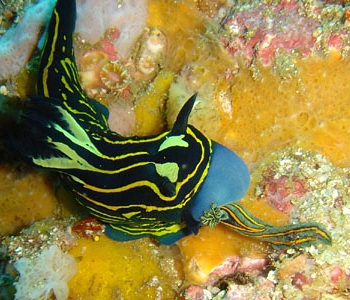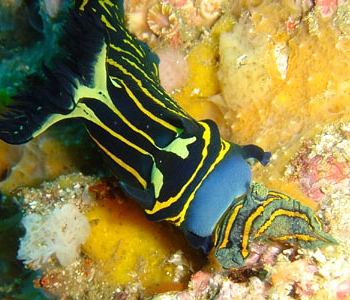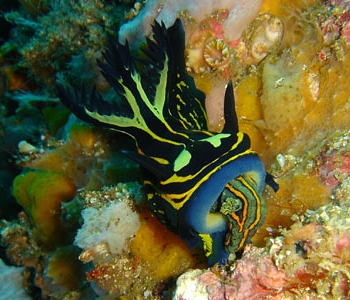Roboastra luteolineata - Feeding behaviour!
January 23, 2007
From: Graham Abbott


Hi Bill,
I have a question about some feeding behaviour I have recently witnessed and photographed. I have a few great sites where we can find the cannibal nudibranch Roboastra luteolineata and I've been observing them fairly closely recently. On my most trip out I photographed a very interesting sequence in which the cannibal nudi ate a spat out another nudibranch twice. I can only think that the other nudibranch is a hydroid eater, certainly looks like it with the skin colouration, to me it seems kind of like a C. willani which I do believe is a hydroid eater and ingests the hydroid into it's skin, is this correct?
Locality: South Rinca, Komodo, 8m, Komodo, Indonesia, 14.1.07, Large pinnacle. Length: no exact data!. Photographer: Graham Abbott.
I don't have any of my ID books with me, they are all out on another live aboard at the moment. I am hoping you can help me ID the lucky nudi that got away and let me know if it is indeed a poisonous species.Look forward to hearing back from you when I get back from my next trip!
Kind regards
Graham
graham@diving4images.com
Graham Abbott, 2007 (Jan 23) Roboastra luteolineata - Feeding behaviour!. [Message in] Sea Slug Forum. Australian Museum, Sydney. Available from http://www.seaslugforum.net/find/19296
Dear Graham,
Thanks for the interesting sequence of photos. The fortunate 'prey' animal is very similar to a photo I have identified as Tambja tentaculata [message #14883]. We don't know much about that recently named species, but if it is like other species of Tambja, it will feed on bryozoans. Chromodoris willani is quite different in shape and colour, and is a sponge feeder.
Nudibranchs of the genus Roboastra are well-known as hunters, but it seems they restrict their prey to other nudibranchs of the family Polyceridae. They certainly seem to eat smaller members of their own species, so I guess you can call them cannibals, but they are not exclusively cannibals. The two species most studied are the tropical American R. tigris which feeds on Tambja abdere and T. eliora, and the European R. europaea, which feeds on a variety of polycerids (Megina & Cervera, 2003). From work on R. tigris, we know that distasteful chemicals are incorporated in tissues of the bryozoan-feeding species of Tambja, and then transferred to the Roboastra, when it eats them (Carte & Faulkner, 1986). I presume something similar could happen with Tambja tentaculata and R. luteolineata, but I doubt it would lead to the Roboastra rejecting the Tambja. It is possible the Roboastra was just being greedy. These hunters seem to attack by reflex action whenever they come across prey. Perhaps it discovered it didn't really have room inside once it started swallowing.
-
Carte, B. & Faulkner, D.J. (1986) Role of secondary metabolites in feeding associations between a predatory nudibranch, two grazing nudibranchs, and a bryozoan. Journal of Chemical Ecology, 12(3): 795-804.
-
Megina, C. and Cervera, J. L. (2003) Diet, prey selection, and cannibalism in the hunter opisthobranch Roboastra europaea. Journal of the marine biological Association, U.K. 83: 489-495.
Best wishes,
Bill Rudman
Related messages
-
Roboastra luteolineata laying eggs
From: Deb Aston, May 6, 2010 -
Re: Roboastra luteolineata - Feeding behaviour!
From: Graham Abbott, August 4, 2007 -
Re: Roboastra luteolineata - Feeding behaviour!
From: Graham Abbott, July 24, 2007 -
Roboastra luteolineata eating Nembrotha kubaryana
From: K. Anderson, February 7, 2006 -
Roboastra luteolineolata from Great Barrier Reef
From: Pasquale Pascullo, December 19, 2005 -
Re: Feeding habits of Roboastra
From: Bieke Daneels, July 10, 2004 -
Roboastra luteolineata from Kapalai
From: Maliza, June 4, 2003 -
More on Roboastra feeding
From: Ross & Diane Armstrong, October 26, 2001 -
Roboastra luteolineata vs Tambja verconis
From: Ross and Diane Armstrong, October 25, 2001 -
Roboastra luteolineata from the Solomons
From: Scott Johnson, September 30, 2001 -
Roboastra cf. luteolineata from Sth Africa
From: Valda Fraser, July 3, 2001 -
Re: T. affinis v. R. luteolineata
From: Ross and Diane Armstrong, April 24, 1999 -
Tambja affinis v. Roboastra luteolineata
From: Ross Armstrong, April 23, 1999 -
Re: Roboastra luteolineata
From: Ross Armstrong, February 24, 1999 -
Robastra luteolineata - new for New Zealand
From: Ross Armstrong, February 22, 1999
